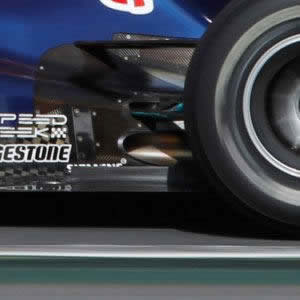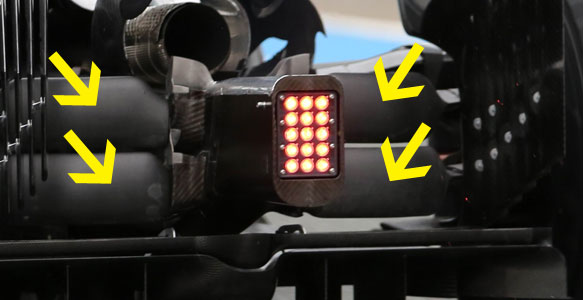 |
| What the ****? |
Yes, they have done it again. The FIA have shot themselves in the foot.
Back in 2012 you may recall 'stepped noses'. In an effort to increase driver safety and probably aesthetics, the FIA rule makers reduced the maximum height forward of the front bulkhead (basically the nose in front of the wheels). With the teams wanting to continue to maximise the airflow under the car, their ingenious idea was to create a very ugly 'step' in order to bring the front of the nose down to the required height. This was certainly a fail from the FIA not considering how there rules would be interpreted.
This year the FIA thought they would go a step further, and now state the tip of the nose must be no higher than 185mm from the reference plane (floor of the car). The nose must also be no higher than an imaginary diagonal line drawn from the front bulkhead (where the drivers feet are) to the front of the nose.
Unfortunately this backfired again, as the FIA dictated the chassis height to only reduce by 100mm. Que teams again to take back their advantage with weird solutions.
 |
| The penis shaped protrusion of the Torro Rosso |
In order to meet the low nose point required many teams have adopted a penis shaped protrusion to satisfy the regulations. While some became accustomed to the stepped noses, these phallic extensions are pretty horrific. Even Anne Summers tweeted :
“So it looks like Toro Rosso have taken inspiration from our sex toy collections #collaborationopportunity”,
Possibly the worst interpretation was the 'twin tusk' design of the Lotus. The release pictures showed a monstrosity of large tusk like protrusions extended from the front of the car with one tusk longer than the other. This stems from the FIA ruling stating the tip of the nose 'has a single, cross sectional area of 9000m2'.
 |
| The unsightly 'twin tusk' of the Lotus E22 |
Take a note of the word single there, which is what Lotus have done with one single protrusion meeting the regulation requirements. These protrusions re-inforce the wing pillars to form a crash structure and act to direct airflow, but are quite thick which could offset this advantage.
Teams such as Ferrari, and in a more graceful fashion with the best looking car of 2014 Mercedes, have abadoned the penis extension and gone with a more conventional design. This is even more so on the Ferrari, with a very low 'vacuum' cleaner nose. Some may argue that the Ferrari nose is actually worse.
 |
| The 'vacuum nose' Ferrari |
So what actual performance gains come from the shape of the nose? As discussed the aim of the game is to get as much air flow under the nose as possible to allow the underbody aerodynamics and diffuser to work to their full potential. This is why we have had very high noses in recent years. However, although visually striking the shape of the nose does not carry equally striking performance gains. Ferrari James Allison, who worked on the Lotus tusk nose before joining Ferrari this year stated on the different concepts "There is not that much in it - they are just good to talk about because they are right up at the front of the car."
 |
| In a year of ugly horrors Mercedes still produce another great looking car |
Ban on Exhaust Blowing
 |
| Exhaust gas being directed around the diffuser |
What really carried a massive advantage in recent years was exhaust blowing. Back in 2010, Redbull experimented with blowing hot exhaust gasses around the rear diffuser, a device at the back of the car which generates huge downforce and grip. The hot gasses coming out of the exhaust almost created an invisible barrier to keep air flowing through the diffuser affectively. The hot gasses also created pressure change which sucked more air through the diffuser. The result was a big increase in grip when the driver hit the throttle pedal coming out of corners. Redbull designer Adrian Newey knew he was onto a winner and and the aerodynamics of the Redbull were built around this concept to get maximum advantage, which led to the team's dominance.
 |
| Note the location of the exhaust exit |
By 2011 every team was at it, and the designs becoming more advanced and hugely affective. I remember attending Silverstone that year, just as the FIA announced a ban on this technology only to get slapped back into place by teams complaining over lost performance. What I didn't really hear on television became much more apparent on track. The engines sounded like a low thudding machine gun when the cars braked for the corner and an acrid smell entered my nostrils. The video below gives you a good idea of the sound you for some reason never heard well through your television:
For the following season, the FIA stipulated the exhaust exit on the car had to be placed high up upon the sidepods rather than next to the diffuser. However teams as ever employed methods to get around this. With a small indent on the exhaust exit to direct exhaust gas down, using the 'co-anda' affect exhaust blowing was still, if a much more diminshed, important generator of downforce on the cars.
However for 2014 we now see the exhaust located in a central position ahead of the diffuser, making it impossible to direct exhaust gas towards the diffuser. "There will be a lot less downforce as there will be no [exhaust] blowing" stated Jenson Button before testing. "I don't care what they say, there is still a massive amount of blowing on an F1 (2013) car."
 |
| Exhaust exit location for 2014 |
This change will mean a big reduction in downforce, and with the torquey turbo engines making wheel spin easier you will be seeing a lot of cars going sideways when exiting slow corners. Great!
Wing Changes
In an effort to reduce more downforce from the new cars the FIA and have made changes to the front and rear wing rules
In an effort to reduce punctures, the front wing has been shortened from 1800mm to 1650mm. As the front wing generates a vast amount of downforce on the car this will have a big impact. This also makes it harder for the front wing to direct air around the outside of the tyre. Teams will try a claw a small advantage back with now being able to direct airflow in between the car and the tyres.
The virtual box that the rear wing has to sit in stipulated by the FIA is now 20mm smaller. There is also the removal of the beam wing. Smaller area means less downforce. However in an effort to claw more downforce back McLaren has an innotive solution of shaping the rear suspension into an aerodynamically detailed 'blocker'. This blocks airflow travelling around the coke bottle rear bodywork of the car heading towards the diffuser. A pressure difference speeds up airflow under the car creating more downforce. This may give McLaren quite a big advantage in 2014 and is hard to copy due to the need of other components to work in harmony.
 |
| The new Mclaren's innotive 'blockers' |
All these changes combined equal significant downforce loss. But ask any experienced F1 geek and he will tell you these losses will be clawed back in a year or two with new innovative concepts...



No comments:
Post a Comment